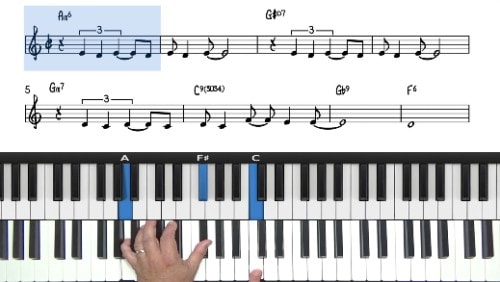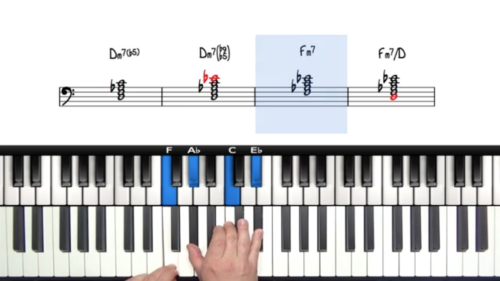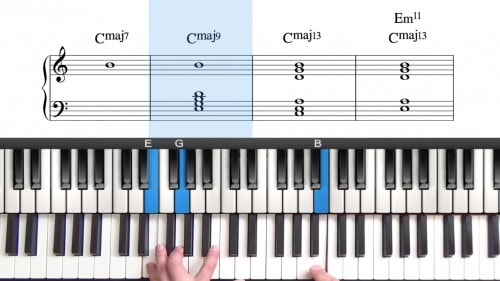251 Drill with Inner Voice Movement
In this lesson we take the same extended 251 progression that we covered in the previous lesson but we apply inner voice movement over the Imaj7 chord to add more interest at the point of resolution.
When playing jazz standards, we often have both harmonic and melodic space over the Imaj7 chord in a 251 progression, and so being able to visualise this inner voice in all 12 keys is a very useful piece of musical vocabulary to have at our disposal.
5 to #5 to 7 to 6
This inner voice moves chromatically upwards from the 5th to the #5th, we then move up a minor 3rd to the major 7th, and finally the inner voice moves down a whole step to rest on the 6th of the chord.
This inner voice movement can be applied with different rhythmic variations and patterns and it is commonly heard in solo jazz piano performance.
Related Theory Lessons
Check out the related theory lessons where we explore the concept of inner voice movement in more detail. Inner voices can be applied to all chord types, but for this lesson we exclusively focus on inner voice movement over the Imaj7 chord in the major 251 progression.
Lesson Downloads
-
Whole Step Extended 251s – Type A File Type: pdf
Practice Tips
-
It's very important to be able to visualise this inner voice movement on the piano keyboard.
-
The first example in the lesson shows the inner voice in the notation for clarity into the concept.
-
When practicing this drill we must see the 'path' of 5th to #5th, to 7th, to 6th, and also 5th to #5th to 6th.
- Once we can visualise this movement on the piano keyboard in all 12 keys, it is then at our disposal to add spontaneously and creatively into our jazz piano arrangements.








Hi Hayden,
I’ve been doing this drill for a week or two and it’s coming along. I’m also applying it to some tunes and it’s nice to have it to use on those major 7 and major 6 chords. Thanks for that.
Just a quick question. In the video you demonstrate the drill in the Type A inversion. I did a little bit with the inner voice drill in the type B inversion position. Is it worth putting in some time to get the type B fluent, or is it better to just know the type A real well and then I’ll know the 5#576 well enough to just take it from there when I apply 5#567 to the tunes? Also I like the way you break up (toggle) the chords and I do that in the B position too.
Powerful stuff. I like it. Thanks.
Brad
I am wondering about pedaling during this “movement”. It can sound messy.
Hi Don,
Good question.
It’s good practice to lay off the pedal for this movement and you shouldn’t need to keep the pedal down as the other notes of the chord are being held down with your fingers as you play the inner voice movement.
When moving from 5 to #5, if the pedal is applied this will sound very dissonant because we are sustaining 2 notes a half step apart. So always keep that in mind.
Let me know if I can help further here.
Cheers,
Hayden
Hi Hayden,
While practicing today, I had the same question in mind that brad1 had asked (didn’t see your answer). You only practice the inner voice movement in this exercise with the type A voicing. I think that is because a type B voicing would cause it to be an outer voice movement since the 5th would be on the top of the RH voicing. Is that something to be avoided, or can it be used also?
Hi Ray,
Great questions and for some reason I missed Brad’s question.
I’d say stick with type A as the purpose of this drill is inner voice movement, and in Type B we have the 5th on top which means that it’s not an inner voice and could interfere with the melody.
Just playing around with this now, we could add the inner voice under the right hand for the Imaj7 chord. For example a 251 in C Major in Type B, our notes would be:
Left Hand = Root
Right Hand = B-D-E-G
Our right hand thumb would be playing the note B, and we could then move it down to the note G and start the voice movement there G-G#-B-A with our thumb. This way it would still be ‘inner’ voice movement as the idea is that this movement happens inside the harmony.
I’ve actually never done that drill before, but it does sound pretty hip to my ears. If you like the sound of it then certainly incorporate it into your practice as ultimately it will just give you a deeper understanding and ability to visualise the tones and movement from 5-#5-7-6.
I find that the original Type A drill I cover is really useful and applicable in many situations when playing jazz standards, and so definitely learn that one first.
I am covering inner voice movement in my seminar next week, so I will include this as a talking point, you can register here: pianogroove.com/live-seminars/what-is-inner-voice-movement/
If you have any further questions just let me know.
Cheers,
Hayden
Thanks for the replay Hayden. I added your idea to my practice routine this morning. When my LH was down in a lower register (greater distance from the RH) I did it just as you said. When my LH was closer to the RH on the 1 chord I used my LH thumb and index fingers for the inner voice movement (instead of hopping around on my RH thumb). Since the live sessions occur mid-day in my NY time zone, it is difficult for me to attend due to my work hours. I will defiantly view the archive of the session.
That’s great Ray – I’m glad it was useful!
There are a huge number of ways to add inner voices to our harmonies, often depending on the tune we are playing and the melodic and harmonic situation at play.
In my seminar on Wednesday I will go into many different examples using a selection of tunes.
No problem that you just catch the archived version of the seminar – most students do. It makes sense as afterwards I add the slow down controls and chapters which makes it easier to review the material.
The benefit of tuning in live is that you can ask questions, but you can also submit them in advance on this page and I will cover them in the seminar: pianogroove.com/live-seminars/what-is-inner-voice-movement/
Talk soon,
Hayden